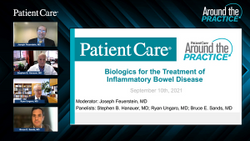Biologics for the Treatment of Inflammatory Bowel Disease - Episode 1
Ulcerative Colitis Versus Crohn’s
Risk factors and characteristics that distinguish ulcerative colitis from Crohn’s disease.
Joseph Feuerstein, MD: Welcome to this Patient Care® Around the Practice titled “Biologics for the Treatment of Inflammatory Bowel Disease.” I’m Dr Joseph Feuerstein, an associate professor of medicine at Harvard Medical School in Boston, Massachusetts. Joining me are Dr Steve Hanauer, a professor of medicine and the medical director of the Digestive Health Center at Northwestern Medicine in Chicago, Illinois; Dr Ryan Ungaro, an assistant professor of medicine in the division of gastroenterology at the Icahn School of Medicine at Mount Sinai in New York, New York; and Dr Bruce Sands, a professor of medicine and the chief of the Dr Henry D. Janowitz Division of Gastroenterology at Mount Sinai in New York.
We’re going to reflect on challenges in inflammatory bowel disease [IBD] management, discuss appropriate strategies for optimizing treatment, and walk through a patient case. Well also involve our audience using several polling questions that will be discussed by our panelists. Welcome, and let’s begin.
To start, we’d like to poll our audience. What’s your level of understanding of disease diagnosis for ulcerative colitis? A) not at all familiar; B) slightly familiar; C) moderately familiar; D) very familiar; or E) extremely familiar? What’s your level of understanding of disease diagnosis for Crohn’s disease? A) not at all familiar; B) slightly familiar; C) moderately familiar; D) very familiar; or E) extremely familiar? And our final question: What’s your level of understanding for the overall management of inflammatory bowel disease? A) not at all familiar; B) slightly familiar; C) moderately familiar; D) very familiar; or E) extremely familiar? I’d like to begin our panel discussion by starting with a brief review of the pathophysiology of inflammatory bowel disease. Dr Hanauer, what are the risk factors associated with developing inflammatory bowel disease?
Stephen B. Hanauer, MD: Thank you, Joe. Let’s begin with the concept that inflammatory bowel disease encompasses both ulcerative colitis and Crohn’s disease, which are 2 distinct but often overlapping conditions. Ulcerative colitis is a diffuse continuous superficial inflammation involving the colon that always begins in the rectum and may include a more proximal amount of the colon that varies among individuals. Crohn’s disease is a transmural disease, meaning it includes both superficial inflammation and inflammation through the bowel wall that leads to complications that can include both strictures or fistula. Crohn’s disease can affect any portion of the GI [gastrointestinal] tract.
We’ve known about ulcerative colitis for many centuries. Crohn’s disease seems to be a relatively new disease. Both of them have a genetic contribution, probably more so in the setting of Crohn’s disease. The gene mutations account for only about 15% of patients who have inflammatory bowel disease. Other risk factors include cleanliness or hygiene. These diseases are more common in cities in the world and in more affluent individuals, and they’re increasing worldwide. We used to think that these were diseases of North America and Western Europe, but we’ve seen a broad expansion of these diseases in third world countries as populations become more Westernized in their habits and lifestyles.
Another important factor has been cigarette smoking. For some reason yet to be determined, smokers seem to be protected against the development of ulcerative colitis but have a worse prognosis in the setting of Crohn’s disease.
Additional factors are quite varied. We don’t know of any specific diet factors associated with these diseases. However, we know that nonsteroidal anti-inflammatory drugs can make the conditions worse or even resemble inflammatory bowel disease. In women, birth control or estrogen therapy may be associated with an increased risk of colitis. But that seems to be a very small aspect of the risk factors. That’s pretty much a very broad description.
Joseph Feuerstein, MD: Thank you, Dr Hanauer. Dr Sands, what role do genetics and the environment play in the development of inflammatory bowel disease?
Bruce E. Sands, MD: Thank you. We’ve long known that inflammatory bowel disease tends to run in families. You’ll often find multiple family members affected. In fact, if you ask people, about 1 of 5 patients may tell you that they have a family member, whether first degree or more distant member of their family, who may be affected. As Steve already said, the risk of familial occurrence is a little higher in Crohn’s disease than in ulcerative colitis.
But sometimes you’ll find families where some individuals have Crohn’s disease and others have ulcerative colitis. This suggests that there’s a commonality of the genetics from the beginning, which in fact turns out to be true. If you look at the genetic architecture that has been elucidated over the last decade and a half, you’ll find that most of the genes that give a little incremental risk for IBD are common between ulcerative colitis and Crohn’s disease. There’s also some commonality with other immune-mediated diseases, as well as, interestingly, some intracellular pathogen diseases like mycobacterial diseases, especially in Crohn’s disease.
There are some genetic risk loci unique to Crohn’s and a handful unique to ulcerative colitis. But genetic testing generally isn’t very helpful in making a diagnosis. I wouldn’t consider that to be routine in clinical care.
On the environment side, Steve has already alluded to a number of possible factors. The genetics also provide a clue, suggesting that it’s the host’s response to the bacterial flora in the gut that’s aberrant. We know this from the first gene discovered and described as a risk factor for Crohn’s disease, the NOD2 gene, which is basically an intracellular bacterial sensor. We don’t know what it is about the bacterial flora that may be wrong, but most patients have a dysbiosis. They have an imbalance of good and bad bacteria in their gut. That seems to be the primary thing in addition to the other more specific things that Steve mentioned.
Transcript edited for clarity.

